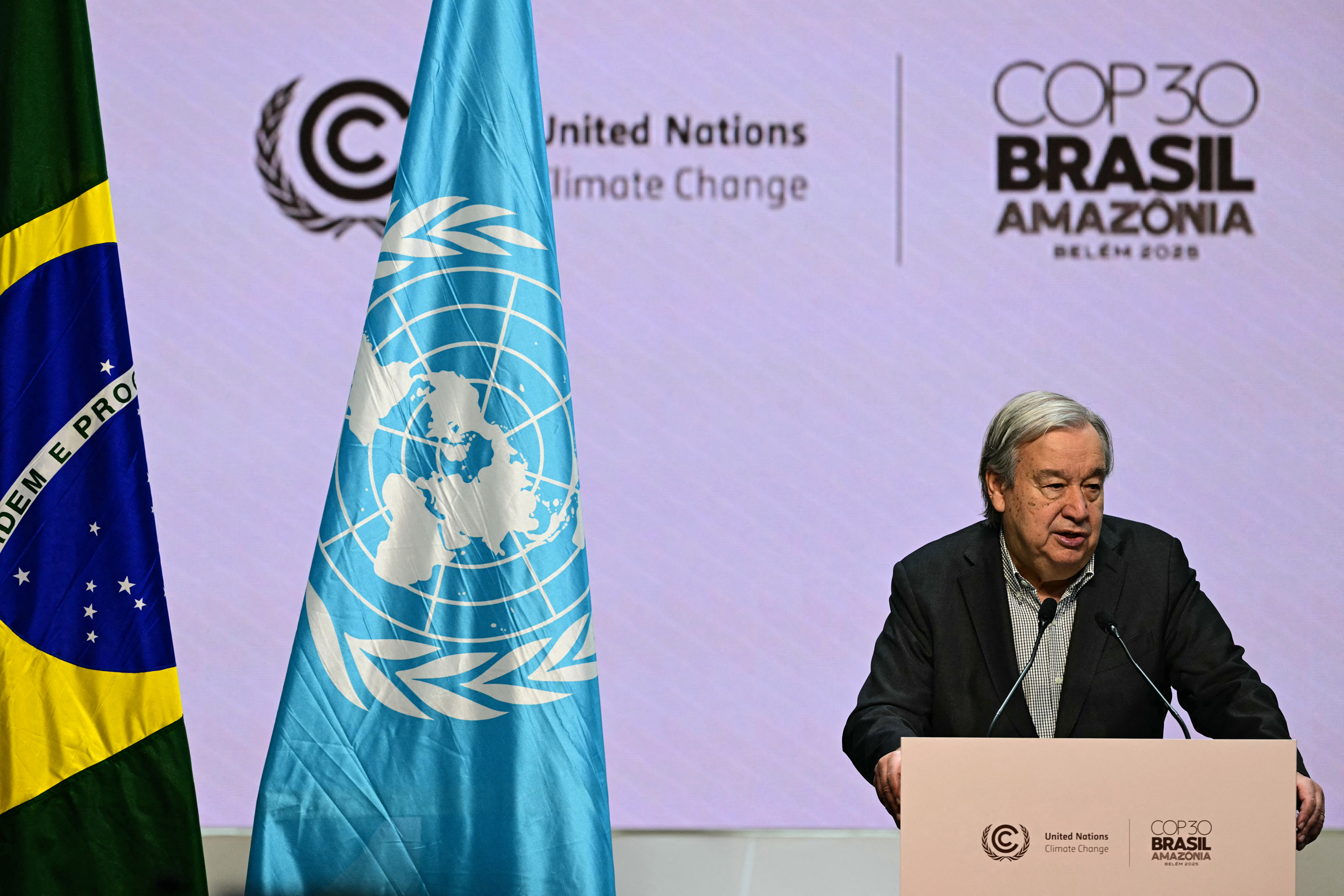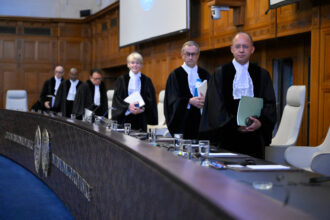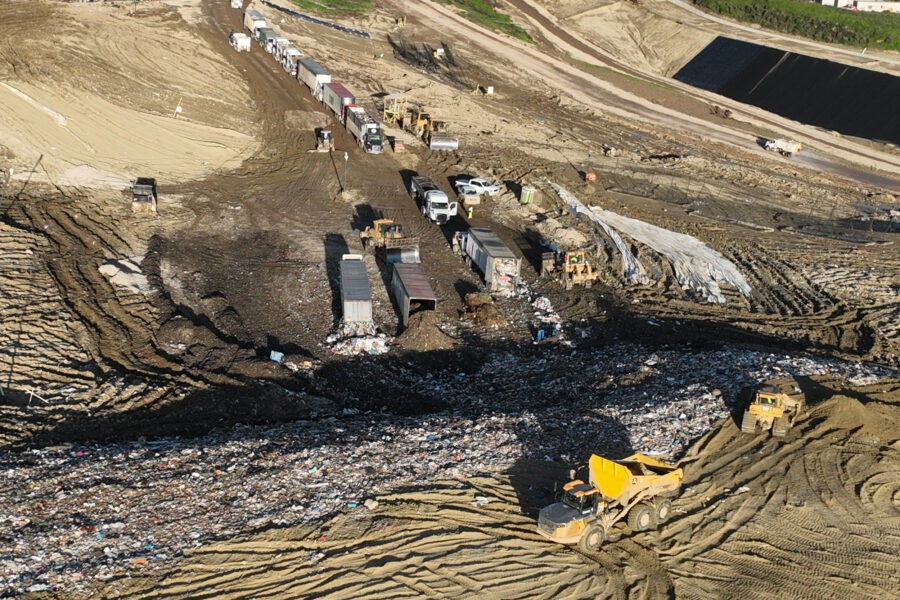BELÉM, Brazil—On the penultimate day of COP30, with nearly 200 countries close to finalizing a global roadmap toward a fossil fuel phase out, United Nations Secretary General Antonio Guterres had a simple message for President Donald Trump and the United States: “We are waiting for you.”
Despite the absence of formal representation from the federal government at the annual climate talks, the country’s influence is still felt. Victor Menotti, interim U.S. coordinator with the Global Campaign to Demand Climate Justice, likened the country’s presence to that of a ghost in the global climate machine.
Several senior U.S. climate diplomats from previous administrations attended COP30, including Todd Stern, Sue Biniaz and Trigg Talley, who all helped negotiate the Paris Agreement. As the U.S. State Department’s lead climate lawyer for more than 25 years, Biniaz guided U.S. legal strategy through decades of international negotiations, culminating in a key role in shaping the Paris Agreement. Talley worked on climate issues at the State Department for nearly 20 years and served as director of the Office of Global Change, coordinating climate efforts across federal departments and agencies.
They attended to facilitate communication between the “We Are Still In” coalition, which brings together U.S. states, cities, businesses and universities committed to climate action despite federal policy shifts.
Stern, a former U.S. special envoy, was instrumental in shaping U.S. climate policy from 2009 to 2016 and helped negotiate the Paris Agreement, the most significant outcome of the 33-year United Nations Framework Convention on Climate Change process. His participation in this year’s talk is evidence of the United States’ enduring influence in a process the Trump administration has rejected, said Menotti, adding that the U.S. still wields power through elite continuity and back-channel influence.
“The U.S. is still shaping what happens in these rooms, even without a delegation,” said Menotti, who has attended 10 climate summits, trying to bring the concerns of nonprofit climate advocacy groups to the negotiating table. “Nobody from the U.S. needed to show up here, and you would still have that big impact.”
That influence is evident far from the United Nations climate negotiation rooms, he added. For example, as the United Nations Framework Convention on Climate Change met last June in Bonn, Germany, to set the stage for COP30, Trump pushed NATO countries to increase their military spending, which sucked the air out of discussions to increase public climate financing, a key agenda item in Belém.
That push, along with the U.S.’s expansion of fossil fuel production and its pressure on allies to buy more fossil gas, has made developing countries uneasy, Menotti said. It also reinforces the perception that developed countries are evading their commitments to reduce emissions faster than developing countries.
Long-time U.S. allies who say they want to advance climate action are still feeding demand for U.S. fossil fuels. That amplifies U.S. influence and undermines a faster energy transition, he added.
In the end, Menotti said, the “ghost” in the COP machine is not just the presence of former U.S. diplomats, but the enduring grip of fossil fuel power.
“There’s the fossil fuel industry, which is global, and central to American industrial, military, financial power,” he said. “The U.S. government, under any administration, is the expression of that power.”
States, Cities and Businesses Step Up
While the U.S. federal government currently is the face of fossil fuel power, members of Congress, governors and business leaders are more pragmatic and want to stay engaged with global climate action, said Lou Leonard, dean of the School of Climate, Environment, and Society at Clark University in Worcester, Massachusetts.
“It’s really important for other governments to see the nuance of how we do things in the United States, that climate action is still happening, even when the federal government isn’t here,” said Leonard, who helped launch the “We Are Still In” coalition.
“You don’t want other governments using the U.S. failure as an excuse to move back, and you certainly don’t want countries walking out and the multilateral process collapsing,” he said.
Leonard said COP is not just about negotiating global rules, but also about generating momentum that pushes governments, businesses and institutions to deliver real-world climate action.
With the rules of the Paris Agreement largely settled, the role of COP as a catalyst for implementation has become more crucial. In that context, he said, the presence of U.S. states, cities, universities and advocacy groups at COP30 is much more than just symbolic. It offers a way to keep climate progress moving despite absent or hostile federal leadership.
An agreement reached during COP30 between California and Baden-Württemberg to share tools for boosting solar power, protecting water supplies from heatwaves and floods and rolling out clean-tech jobs is proof that U.S. states can flex some climate muscle even without the federal government, Leonard said.
This story is funded by readers like you.
Our nonprofit newsroom provides award-winning climate coverage free of charge and advertising. We rely on donations from readers like you to keep going. Please donate now to support our work.
Donate NowThe coalition represents a significant share of the U.S. economy, with participating states accounting for roughly 55 percent to 60 percent of the country’s economic activity, alongside hundreds of cities, businesses and institutions pursuing climate action, Leonard said. Efforts to boost renewable energy, reduce sprawl and other measures by states, cities and businesses could cut U.S. emissions by more than 50 percent by the mid-2030s, even without federal direction.
That still falls short of what’s needed for rapid global decarbonization, but he said it remains critical for sustaining momentum and signaling continued U.S. engagement to the international community.
Is the U.S. Still Climate Spying?
There’s another, far less-visible form of American power that has long shaped the global climate landscape from behind the scenes: control over climate knowledge, said Rachel Santarsiero, director of the National Security Archive’s Climate Change Transparency Project.
For decades, the U.S. intelligence community has tracked climate change as a matter of national security by collecting satellite data through spy satellites, classified assessments and other operations, including reportedly spying on the negotiations at COP15 in Copenhagen, first revealed via Wikileaks.
All that information could help protect vulnerable countries, but remains tightly controlled, giving the U.S. influence over what the rest of the world learns about climate change and what remains hidden.
Santarsiero stressed that while there is no public way to verify active intelligence operations at COP30, it would be unrealistic to assume that the U.S. intelligence community is not monitoring the talks.
“It seems like it would be part of the conversation that the intel community is having,” she said. “Even if climate is not an administration priority, you have to think that something like a phase-out of fossil fuels is going to be in tension with what the administration is trying to do.”
Historically, such monitoring has often been intended to inform diplomacy. Intelligence agencies have long provided environmental data and assessments so negotiators would be better prepared to understand risks, anticipate instability and plan for long-term security implications, helping governments respond to climate threats.
While the COPs are often seen as a neutral space where countries work together, she said, they are also a time when major powers work to protect their interests and shape outcomes.
She said it’s impossible to separate COP30 from U.S. energy and geopolitical strategy, pointing to the administration’s push to expand coal, oil and gas production even as negotiators pressed for a fossil fuel phase-out.
“You have to think that something like a phase-out of fossil fuels is going to be in tension with what the administration is trying to do … I mean, it all leads back to U.S. competition,” she said. That means the U.S. remains embedded in the COP process, not as a stakeholder at the table, but as a strategic actor guarding its national interests.
U.S. influence on the U.N. climate talks hasn’t vanished. It’s just more diffuse and difficult to see. Even without a flag on the dais, the U.S. is still defending its markets, pressuring other countries on their energy policies and evaluating intelligence reports far from the plenary floor.
“It would be naive to pretend that’s not happening,” Santarsiero said. “These things aren’t necessarily sinister… it’s just another facet of these negotiations.”
About This Story
Perhaps you noticed: This story, like all the news we publish, is free to read. That’s because Inside Climate News is a 501c3 nonprofit organization. We do not charge a subscription fee, lock our news behind a paywall, or clutter our website with ads. We make our news on climate and the environment freely available to you and anyone who wants it.
That’s not all. We also share our news for free with scores of other media organizations around the country. Many of them can’t afford to do environmental journalism of their own. We’ve built bureaus from coast to coast to report local stories, collaborate with local newsrooms and co-publish articles so that this vital work is shared as widely as possible.
Two of us launched ICN in 2007. Six years later we earned a Pulitzer Prize for National Reporting, and now we run the oldest and largest dedicated climate newsroom in the nation. We tell the story in all its complexity. We hold polluters accountable. We expose environmental injustice. We debunk misinformation. We scrutinize solutions and inspire action.
Donations from readers like you fund every aspect of what we do. If you don’t already, will you support our ongoing work, our reporting on the biggest crisis facing our planet, and help us reach even more readers in more places?
Please take a moment to make a tax-deductible donation. Every one of them makes a difference.
Thank you,












